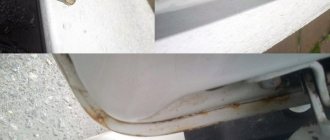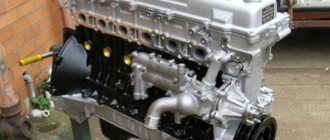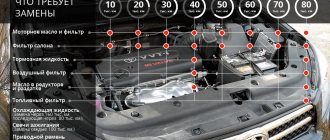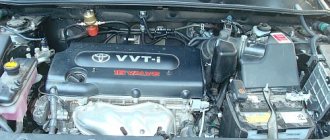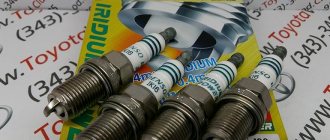The 2AD-FHV diesel engine from Toyota has been manufactured since 2005. It was intended for use on the European market, so the motor was assembled in the UK. Let's consider the design features of the engine, typical malfunctions, as well as operating parameters.
Characteristics
The 2AD-FHV engine has a volume of 2231 cc. cm. Its power is 177 horsepower, with a maximum torque of 400 N*m, achieved at 2800 rpm.
The cylinder block is made of light alloy aluminum, and the liners are cast iron, with thin walls. The design features of the block will be discussed in detail below. The power unit uses a Common Rail injection system with a compression ratio of 15.7. A chain drive is used as a timing drive. The engine uses VGT turbocharging. It is necessary to use high quality diesel as fuel. For optimal engine operation, it is necessary to use 5W-30 oil in an amount of 5.9 liters.
AD series timing belt
Judging by reviews from car enthusiasts, the service life of the Toyota 2AD-FHV engine is about 250,000 km.
Consumption
The average diesel fuel consumption of a Toyota 2AD-FHV engine per hundred kilometers depends on the specific model of the car in which it was used. Below are some data:
Avensis T250 after update
- Toyota Avensis T250 with manual transmission 6 – 6.1 l;
- Toyota Avensis third generation with six-speed manual transmission – 5.9 liters.
Which Toyotas was it installed on?
The engine of the 2AD-FHV model was equipped with the following brands of Toyota cars:
- Avensis T250 from 2005 to 2009;
- Auris E150 from 2006 to 2012;
- RAV4 XA30 from 2007 to 2012;
- Avensis T270 from 2009 to 2021;
- Verso AR20 from 2009 to present;
- RAV4 XA40 from 2012 to 2021.
Station wagon Avensis T270 after restyling
Motor reliability
To create this engine, an aluminum block and cast iron liners were used. Earlier generations used Denso common rail fuel injectors and a catalytic converter. Next, they began to use non-repairable piezoelectric injectors and particulate filters. These engines received the modification 2AD-FHV. A turbine is installed on all modifications.
During the initial operation of these engines, serious problems arose, such as oxidation of the cylinder block and soot entering the engine intake system, which led to a large number of recalled vehicles under warranty. In engines produced after 2009, these shortcomings have been corrected. But these engines are still considered unreliable. These engines were installed in cars mainly with a manual transmission, only the 150-horsepower version was equipped with a six-speed automatic. The timing chain is changed at an interval of 200,000 -250,000 km. The service life of these models was set by the manufacturer to be up to 500,000 km, but in fact it turned out to be significantly less.
Briefly about the mechanical part
In this section we will consider the main design features of the 2AD-FHV engine.
Block
The cylinder block of the Toyota 2AD-FHV diesel engine is manufactured using identical technology to the latest generation gasoline internal combustion engines. For its production, an aluminum alloy is used, with the formation of an open cooling jacket. The sleeves are made of cast iron. They have thin walls, which on the outside have an uneven surface structure. This makes it possible to improve heat dissipation and obtain high strength of connection with the block when the sleeve is fused.
Cylinder block 2AD
For Toyota 2AD-FHV engines, full-size, light-alloy pistons with an additional polymer coating on the skirt are used. The combustion chamber is located in the cylinder head, equipped with a specialized cooling channel. Under the inner part of the upper compression ring, located in the corresponding groove of the piston, there is a ni-resist insert. Floating pins are used to connect the pistons to the connecting rods.
To operate the balancing mechanism, a gear transmission is provided through the crankshaft. The cylinder block is equipped with a one-piece crankcase, in which the crankshaft main bearing caps are cast from cast iron.
The balancing mechanism is driven by a gear
This design of the cylinder block of the 2AD-FHV power unit does not provide for major repairs.
Timing drive
This Toyota power unit uses a DOHC 16V gas distribution mechanism. It involves the use of four valves for each cylinder and two camshafts in the cylinder head. Translation of translational motion is carried out using a single-row chain. Its tension is adjusted automatically, thanks to the use of a hydraulic tensioner with a locking mechanism. A special oil nozzle is responsible for supplying the required amount of lubricant to the chain.
1 — EGR cooler, 2 — turbocharger, 3 — from the heater, 4 — to the heater, 5 — to the radiator, 6 — oil cooler, 7 — from the radiator, 8 — thermostat
The exhaust camshaft is driven by a chain transmission through the crankshaft. Next, the intake camshaft begins to rotate through a gear transmission. It transmits forward rotation to the vacuum and high pressure fuel pump.
Turbine
The 2AD-FHV power units are equipped with a first-generation vacuum-driven turbocharger. They use variable geometry of the guide vane. The turbine is provided with liquid cooling. A turbocharger has the following advantages:
Turbocharger 2AD
- at high speeds the back pressure decreases;
- at low speeds, power increases;
- no need to use a bypass mechanism;
- the ability to maintain the optimal boost pressure value at various engine speeds.
They are provided by the design features of the turbine:
- if the Toyota engine operates at low speeds and with a reduced load, then the pneumatic drive ensures partial closing of the turbine blades. This occurs as a result of the influence on the control ring, which promotes the rotation of the turbine blades due to the presence of a hinge joint. This process is accompanied by an increase in the rate of gas supply to the turbine, as a result of which the boost pressure increases and the engine torque increases;
- if the power unit operates under significant loads with an increased rotation speed, the turbine blades will move towards the opening. This will reduce exhaust resistance by maintaining optimal boost pressure.
Piezoelectric injector. 1 - sprayer, 2 - valve, 3 - piston No. 2, 4 - piston No. 1, 5 - piezoelectric element
Reviews from motorists
Reviews from the owners of these motors characterize them as very finicky and capricious engines that need to be very carefully monitored and cared for. Otherwise, all the money saved on fuel will be spent on repairing these units.
Knowing all the problems of the internal combustion engine, the Toyota company, subject to timely completion of routine maintenance for Europeans, extended the engine warranty from 5 years to 7 years and from 150,000 km to 170,000 km, depending on which event occurs faster.
Order a contract engine Tired of paying fines? There is an exit! Forget about fines from cameras! An absolutely legal new product - Traffic Police Camera Jammer, hides your license plates from the cameras that are installed in all cities. More details at the link.
- Absolutely legal (Article 12.2);
- Hides from photo and video recording;
- Suitable for all cars;
- Works through the cigarette lighter connector;
- Does not cause interference to radios and cell phones.
Find out what the secret is –> January 10, 2017
In the mid-2000s, Toyota engineers completed the development of a new diesel engine, as a result, production of Toyota 1AD-FTV and 2AD-FTV engines was launched on the automaker's assembly line. These power units, with a displacement of 2 and 2.2 liters, respectively, became the most popular Toyota diesel engine of the late 2000s for the Toyota RAV4 and Toyota Corolla Verso, Avensis. In our review we will look at the features of the 2 AD-FTV engine (2.2 liters), which is rarer compared to the two-liter version.
Possible troubles
Reviews from owners of cars with a Toyota 2AD-FHV engine are often accompanied by the following problems during engine operation:
- observation of increased oil consumption, which is accompanied by the formation of carbon deposits in various components of the power unit. In this case, most often, carbon deposits form in the EGR channel, even in the absence of excessive oil consumption. This determines the need for regular cleaning of the EGR and intake, every thirty thousand kilometers;
- failure of the cylinder head gasket. If you notice the problem in time, you can get away with replacing the cylinder head gasket. If you don't pay attention, we install a new block. This is due to the fact that the manufacturer does not provide for the replacement of individual components of the power unit.
Block head 2AD
Observation of leaks from under various engine elements. Among them:
- water pump;
- timing chain cover;
- oil pan.
Engine lubrication
Malfunctions in the fuel system manifest themselves in the following components:
- fuel injector booster;
- main injectors;
- destruction of the internal elements of the injection pump.
Nozzles for cooling and lubrication of the piston
The complex of equipment for reducing toxicity also exhibits periodic malfunctions. This manifests itself in the failure of the following parts:
- throttle valve drive;
- differential pressure sensor;
- EGR valve;
- exhaust fuel injectors;
- neutralizer, due to its limited service life (no more than 200,000 km, provided that high-quality diesel fuel is used).
Dismountable oil filter with replaceable cartridge.
There are also interruptions in the operation of the particulate filter regeneration complex. In most cases, to fix the problem you will need to update the control unit software.
Tips for choosing oil
The differences between 1AD and 2AD are as follows: the volume and engine of the 2AD-FTV model uses a balancer system. Chain drive of the gas distribution mechanism. It is better to fill the oil in 1AD models with diesel approval for diesel engines according to the API - CF system according to ACEA -B3/B4. For model 2AD - with approval for diesel engines with particulate filter C3/C4 according to the ACEA system, according to API - CH/CI/CJ. Using engine oil with additives for particulate filters will extend the service life of this spare part.
Engine reliability and maintainability
For its power, the engine showed very decent efficiency characteristics.
The timing chain mechanism has shown a high level of reliability. Installing hydraulic compensators relieves drivers of the need to adjust valve thermal clearances. The oil filling volume is 6.5 liters, the standard replacement frequency is every 10 thousand kilometers. The best option for filling the engine is 5W-30 oil.
Particulate filter
A well-established set of “cons” of the 2AD-FHV engine is gasket failure, rapid contamination of the USR valve. Over time, the geometry of the turbine is disrupted, which requires additional repairs. A standard problem for Japanese diesel engines is shortcomings in fine-tuning the design of the particulate filter, and, as a result, frequent failures of the regeneration system. The engine has a declared mileage of 250 thousand kilometers without major repairs. But that's his limit.
New diesel – basis for environmental research
Japanese engine manufacturers positioned the 2AD-FHV motor as a completely new word in the fight to reduce the harmful effects of exhaust gases. The “heart” of the idea was the latest 2.2 D-CAT (Diesel Clean Advanced Technology) exhaust cleaning system. The goal of the management of Toyota Motor Corporation was to transfer the European lines of the most popular models of the first decade of the new century from the D4-D system to the more progressive D-CAT, under the Euro 5 protocol.
The 2AD-FHV engines are equipped with complex combinations of Denso piezoelectric injectors. With their help, you can create pressure with a force of 35-200 MPa. Unlike other systems, the 2.2 D-CAT has an additional fifth injector, in the manner of French Renaults.
D-CAT system diagram
The purpose of the five-injector combination, coupled with a nitrogen oxide catalyst, is to effectively regenerate the particulate filter without the risk of oil getting into the diesel fuel. Types of exhaust gases:
- carbon monoxide CO;
- soot particles;
- Nitric oxide.
The USR drive type is electromagnetic (with a spool valve and a position sensor) or with a DC motor and a contactless Hall sensor. A complex of complex physical and chemical research and testing programs made it possible to reduce the level of harmful gas emissions during engine operation to 144-195 g/km.
This is interesting: Toyota Corolla battery maintenance
Maintenance schedule for Toyota 2AD-FHV 2.DCAT internal combustion engine
Oil service
| Periodicity | every 10,000 km |
| Lubricant volume in internal combustion engine | 6.5 liters |
| Needed for replacement | about 5.9 liters |
| What kind of oil | 0W-30, 5W-30 |
Gas distribution mechanism
| Timing drive type | chain |
| Declared resource | is not limited |
| On practice | 240 thousand km |
Valve clearances
| Adjustment | not required |
| Adjustment principle | hydraulic compensators |
Replacing consumables
| Air filter | 10 thousand km |
| Fuel filter | 20 thousand km |
| Filter in the tank | 80 thousand km |
| Spark plug | 80 thousand km |
| Rec. belt | 100 thousand km |
| Antifreeze | 4 years or 80 thousand km |
How to remove soured injectors from a 2.2 D-CAT diesel engine

